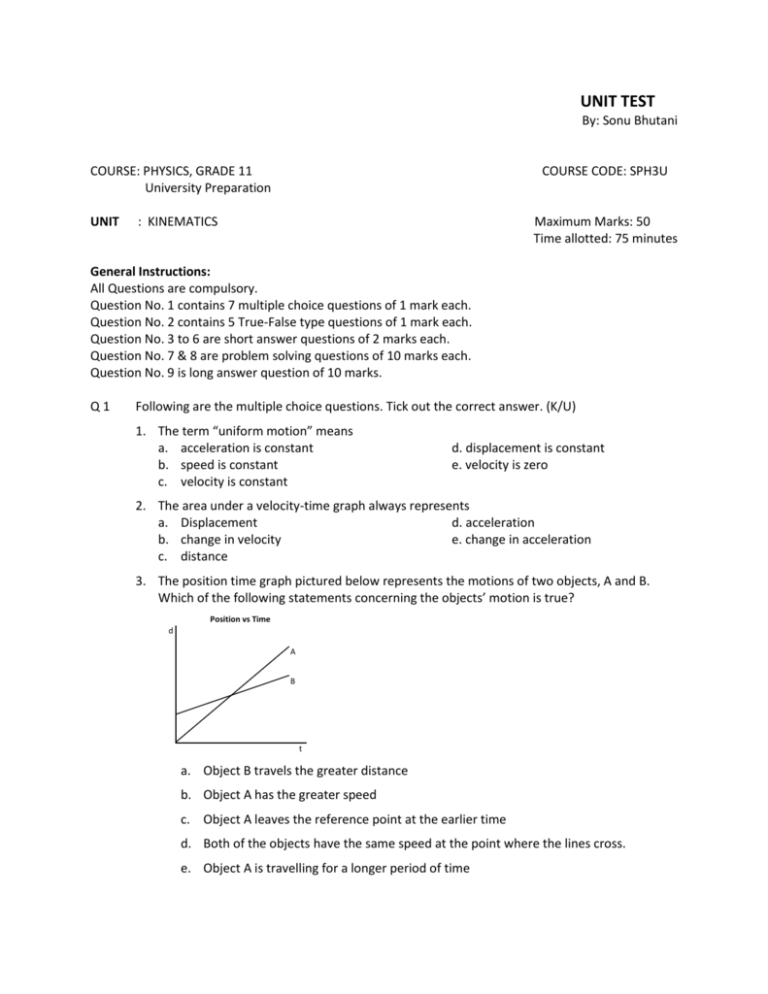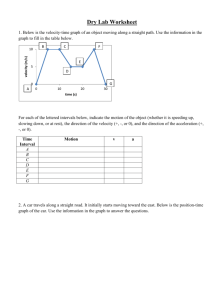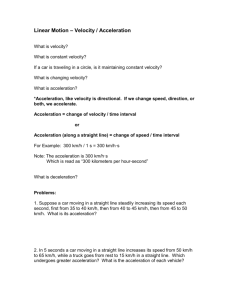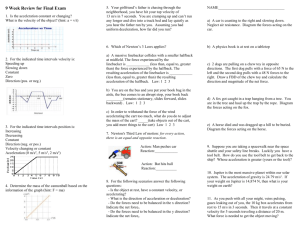SPH3U - Kinematics Unit Test with solutions
advertisement

UNIT TEST By: Sonu Bhutani COURSE: PHYSICS, GRADE 11 University Preparation UNIT COURSE CODE: SPH3U : KINEMATICS Maximum Marks: 50 Time allotted: 75 minutes General Instructions: All Questions are compulsory. Question No. 1 contains 7 multiple choice questions of 1 mark each. Question No. 2 contains 5 True-False type questions of 1 mark each. Question No. 3 to 6 are short answer questions of 2 marks each. Question No. 7 & 8 are problem solving questions of 10 marks each. Question No. 9 is long answer question of 10 marks. Q1 Following are the multiple choice questions. Tick out the correct answer. (K/U) 1. The term “uniform motion” means a. acceleration is constant b. speed is constant c. velocity is constant d. displacement is constant e. velocity is zero 2. The area under a velocity-time graph always represents a. Displacement d. acceleration b. change in velocity e. change in acceleration c. distance 3. The position time graph pictured below represents the motions of two objects, A and B. Which of the following statements concerning the objects’ motion is true? Position vs Time d A B t a. Object B travels the greater distance b. Object A has the greater speed c. Object A leaves the reference point at the earlier time d. Both of the objects have the same speed at the point where the lines cross. e. Object A is travelling for a longer period of time 4. The distance travelled by a body is directly proportional to the square of the time taken. It’s acceleration a. Increases c. becomes zero b. Decreases d. remains constant 5. A ball is thrown vertically into the air and when it returns after an interval of 2 seconds, it is caught. Which one of the following statements is true if the acceleration due to gravity is 10 m/s2 and air resistance can be neglected: a. The acceleration at the top of its flight is 10 m/s2. b. The time taken for the descending motion does not equal the time taken for the ascending motion. c. The maximum height it reaches does not depend on the force of gravity. d. The acceleration after it leaves the hand is 10 m/s2 downwards. 6. A rock is thrown vertically upwards with a speed 'v' from the edge of a cliff. At the same moment, a second rock is thrown vertically downwards with the same initial speed 'v'. Which of the following statements regarding the motion of the rocks is true (ignore air resistance.)? a) The rock which was thrown upwards reaches the bottom of the cliff with a higher velocity. b) The rock which was thrown downwards reaches the bottom of the cliff with a higher velocity. c) Both rocks reach the bottom of the cliff with the same velocity at the same time. d) Both rocks reach the bottom of the cliff with the same velocity but at different times. 7. The path PQR of a soccer ball kicked from a point P on the ground is shown in the diagram at the right. At point Q, the ball is at its maximum height. Which ONE of the following vectors may represent the acceleration due to gravity of the ball at point Q? a) A b) B c) C d) D Q 2. State TRUE or FALSE for the following statements: (K/U & C) 1. A very massive object will free fall at the same rate of acceleration as a less massive object. 2. An object which is slowing down is represented by a line on a velocity-time graph which is moving in the downward direction. 3. An object with a positive acceleration will be represented on a position-time graph by a line which curves upwards. 4. The direction of the acceleration vector is dependent upon two factors: the direction the object is moving and whether the object is speeding up or slowing down. 5. Person X moves from location A to location B in 5 seconds. Person Y moves between the same two locations in 10 seconds. Person Y is moving with twice the speed as person X. Q 3. A train of 150m length is going towards north direction at a speed of 10 m/s. A parrot flies at a speed of 5m/s towards south direction parallel to the railway track, find the time taken by the parrot to cross the train? (K/U) Q 4. The direction in which an object moves is given by the direction of velocity of the object and not by the direction of acceleration. Explain the statement with suitable example. (A & C) Q 5. In long jump, does it matter how high you jump? What factors determine the span of the jump? (K/U & C) Q 6. There are two displacement vectors, one of magnitude 3 meters and the other of 4 meters, how would the two vectors be added so that the magnitude of the resultant vector be (a) 7 meters (b) 1 meters? (K/U) Q 7. A shell was fired from ground level with an initial speed of 3.5 x 102 m/s at an angle of 30o to the horizontal. Estimate: (K/U) i its time of flight; ii its maximum altitude iii its range Q 8. Two sport cars start from rest at the same place. One accelerates at 0.90 ms-2 for 15 s, and continues at constant speed there after. The other accelerates at 0.85 ms-2 for 20 s and then remains at that speed. Draw both journeys on the same velocity-time graph and determine the time and distance that the second car overtakes the first car. (K/U) Q 9. When a skydiver jumps from an airplane she can reach speeds near 140 km/h during the freefall portion of the dive. Once the parachute is deployed the parachutist’s speed decreases to 10 km/h. Explain why then in physics we consider the acceleration during the freefall to be negative and the acceleration during the time the parachute is deployed to be positive by using your knowledge of vectors and kinematics. (A) SOLUTIONS Q 1. 1. c 2. a 3. b 4. d 5. d 6. d 7. c Q 2. 1. True 2. False 3. False 4. True 5. False Q 3. Relative velocity of Parrot with respect to train = 5+10 = 15m/s Time taken by parrot to cross the train, t = 150/15 = 10s Q 4. When an object is thrown up, the direction of motion of the object and hence its velocity is along vertical in upward direction. As the object moves up, it is always attracted by earth in downward direction i.e., the acceleration is in vertical downward direction. Hence the direction of motion of the object is that of velocity and not that of acceleration. Q 5. Yes, in long jump, it matters how high one jumps, it is explained below. For initial velocity u and angle of projection ϴ the maximum height, h = u2 Sin2ϴ or u2 = 2 h 2g g Sin2ϴ and, horizontal range, R = u2 Sin 2 ϴ = 2 h 2Sin ϴ Cos ϴ = 4h Cot ϴ g Sin2ϴ Thus the span of jump depends upon (i) height h attained (ii) angle of projection, ϴ. Q 6. The magnitude of resultant R of two vectors A and B is given by R = √ A2+B2+ 2 AB Cos ϴ ; where A=3m and B=4m Now R = √ 32+42+ 2×3×4 Cos ϴ . (i) R will be 7m if ϴ = 0o (ii) R will be 1m if ϴ = 180o Q 7. Take up as positive. Initial horizontal speed = 3.5 x 102 m/s cos 30o = 3.0 x 102 m/s Initial vertical speed = 3.5 x 102 m/s sin 30o = 175 m/s Vertical Motion to top of flight: v1 = +175 m/s v2 = 0 a = -9.81 m/s2 t = [v2 - v1]/t = 17.8 s So, time of flight = 2 x 17.8 s = 36 s vav = [175 m/s + 0]/2 = 87.5 m/s So, y = vav t = 87.5 m/s x 17.8 s = 1.6 x 103 m Horizontal Motion: x = vx t = 3.0 x 102 m/s x 36 s = 1.1 x 104 m Q 8. The velocities they reach are 0.9 × 15 = 13.5 ms-1 and 0.85 × 20 = 17 ms-1 respectively. Similar to the problem above, we have: First car (red) distance at time t = 1/2 × 13.5 (t + t - 15) Second car (blue) distance at time t = 1/2 × 17 (t + t - 20) The distance when they meet is the same, so: 1/2 × 13.5 × (2t - 15) = 1/2 × 17 × (2t - 20) Solving gives: Time = 19.643 s Distance = 163.93 m Q 9. Since the skydiver jumps from a plane the acceleration due to gravity causes the divers speed to increase in the negative direction. Therefore the diver’s velocity continues to become more negative over time. If the diver is traveling at a speed of 140km/h, his/her velocity would be -140km/h or 140km/h [D]. Once he/she pulls deploys the parachute, the speed begins to decrease meaning that the velocity is becoming less negative. i.e. changing from -140km/h to -10km/h. Therefore from a vector perspective the change in velocity is positive ∆v = v2 – v1 = (-10) – (-140) = +130 m/s Since the velocity changes positive, therefore the acceleration must be positive. i.e. a = ∆ v / ∆ t









